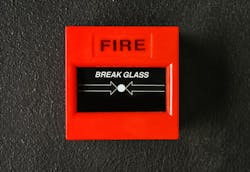5 Key Traits of Modern Fire Protection Systems
An influx of campus construction and renovation projects emerged as colleges modernize aging structures and build new facilities to cater to today’s students who work, study and socialize differently from their predecessors.
In light of National Campus Fire Safety Month in September, the nationwide effort to raise fire and life safety awareness on campuses, it is timely to look at how some of the newest fire protection technologies and innovations can help campuses grow and modernize while keeping a keen focus on safety.
Five Key Traits
1. Advanced Design
The days of bulky, antiquated architecture are in the past. Today, structures on campuses strive to be innovative but inviting at the same time. From parking garages and breezeways to common areas and academic buildings, beauty and aesthetics are now as important as functionality.
Multi-story atriums, cloud ceilings and interior glass dominate the modern architecture that promises to deliver the creative environment, engaged learning and digital connection universities are looking to provide.
Don’t miss: How a Green Wall Gave Life to this Parking Garage
For a fire protection system to fit into this new paradigm, campuses need to utilize components that are purposefully designed to enable this architectural freedom.
Flexible sprinkler drops, for example, offer clear design and functionality advantages over hard pipe since they can mount to a wide range of ceilings and structures and accommodate unconventional building designs with the ideal pendant orientations.
In a recent application, an automatic sprinkler system needed to protect an auditorium that showcased a floating ceiling which could be raised or lowered depending on the event, acoustical or theatrical needs.
Traditional hard pipe sprinkler installations had difficulty protecting the space due to the variability associated with the cloud ceiling, but a customized 16-foot flexible sprinkler drop, installed on an adjustable reel, was able to provide the necessary fire protection.
Where designers once had to incorporate bulky and unsightly soffits packed with insulation to keep sprinkler piping protected in conditioned areas to reduce freeze-ups on campuses prone to colder temperatures, water can now be moved farther into heated spaces within buildings by combining dry sprinklers with flexible drop technology.
A flexible dry sprinkler can connect to the automatic sprinkler system then flexed through an exterior wall or covered balcony to protect an exterior space.
2. Quick Installation
The pace at which universities and colleges are expanding and renovating has dramatically increased. As the shelf-life of technological innovations decreases so does the shelf-life of the buildings that utilize them, and updates are required faster and more often.
Just as grooved technology redefined pipe joining for fire protection systems, it has now eliminated the need for threaded connections on flexible hoses.
Utilizing grooved connections improves the speed at which sprinklers can be installed, especially around existing piping, duct work, or other obstructions and reduces the pain and effort of moving sprinkler heads in the future when retrofitting buildings.
3. Reliability
Turnover in the field of skilled tradesmen and facilities management is growing while building complexity, and the associated fire protection system, is increasing – two trends that make it increasingly important to use products that are designed and installed with confidence.
On topic: Trump Signs Order: American Workforce Skills Shortage
Grooved solutions that feature pad-to-pad connections can be inspected visually, allowing installers to know immediately that a coupling or flexible hose installed properly.
Flexible drops that are listed with a tighter bend radius reduce the chance of improper installations, while using proven kink resistant solutions enable systems to deliver consistent functionality, full flow and leak-free solutions.
4. Hassle-free Maintenance
Once a fire safety system is installed, it must be easy to maintain, or the savings attained from the easy installation are forfeited over the life of the system. Unlike threaded systems, those built with grooved technology make disassembly a clean, straightforward process.
Changing out parts or making repairs is as easy as loosening and then retightening a couple of nuts and bolts with a ratchet or impact driver, which means tidier job sites with less clutter and less wear and tear on sprinkler fitters.
[Stop Wasting Money on Deferred Maintenance]
Furthermore, burst pipes due to freeze-ups are a safety and maintenance nightmare. Campuses that experience freezing winter temperatures should also consider flexible technology for dry sprinklers due to the ability to help reduce and eliminate system impairments that can be taxing on facilities managers.
Simply put, improved technology simplifies maintenance and can eliminate the need for repairs altogether, keeping systems up and running and avoiding shutdowns that displace tenants and disrupt day-to-day activities.
5. Built for Adaptability
Costs can mount rapidly if changing existing infrastructure means replacing the entire system.
With fire protection systems constructed using grooved solutions and standardized outlet sizes, making changes becomes a straightforward exercise whether you use flexible hoses in concealed applications or hard pipe in exposed applications.
Adding or modifying an existing system is no longer invasive, expensive or time-consuming and can be completed when room configurations or the hazards inside a room change.
Universities want beautiful buildings that can be erected or remodeled without compromising safety. By using innovative systems with superior, reliable components, it is possible to install fire safety systems that meet architectural design requirements without negatively impacting safety.
Christopher Kvistad is a product manager for Victaulic.
Two handpicked articles to read next:
